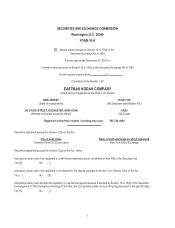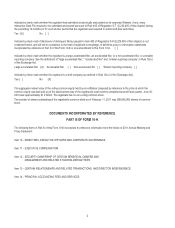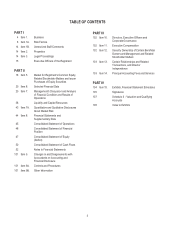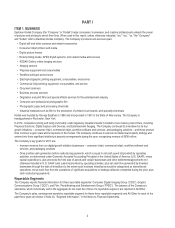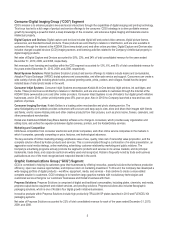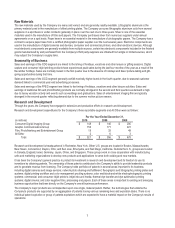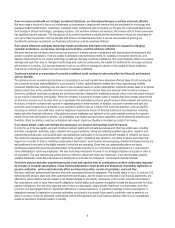Kodak 2010 Annual Report Download - page 13
Download and view the complete annual report
Please find page 13 of the 2010 Kodak annual report below. You can navigate through the pages in the report by either clicking on the pages listed below, or by using the keyword search tool below to find specific information within the annual report.
11
If we are unable to provide competitive financing arrangements to our customers or if we extend credit to customers whose
creditworthiness deteriorates, this could adversely impact our revenues, profitability and financial position.
The competitive environment in which we operate may require us to provide financing to our customers in order to win a contract.
Customer financing arrangements may include all or a portion of the purchase price for our products and services. We may also
assist customers in obtaining financing from banks and other sources and may provide financial guarantees on behalf of our
customers. Our success may be dependent, in part, upon our ability to provide customer financing on competitive terms and on our
customers’ creditworthiness. The tightening of credit in the global financial markets has adversely affected the ability of our
customers to obtain financing for significant purchases, which resulted in a decrease in, or cancellation of, orders for our products
and services, and we can provide no assurance that this trend will not continue. If we are unable to provide competitive financing
arrangements to our customers or if we extend credit to customers whose creditworthiness deteriorates, this could adversely impact
our revenues, profitability and financial position.
Our sales are typically concentrated in the last four months of the fiscal year, therefore, lower than expected demand or
increases in costs during that period may have a pronounced negative effect on our results of operations.
The demand for our consumer products is largely discretionary in nature, and sales and earnings of our consumer businesses are
linked to the timing of holidays, vacations, and other leisure or gifting seasons. Accordingly, we have typically experienced greater
net sales in the fourth fiscal quarter as compared to the other three quarters. Developments, such as lower-than-anticipated demand
for our products, an internal systems failure, increases in materials costs, or failure of or performance problems with one of our key
logistics, components supply, or manufacturing partners, could have a material adverse impact on our financial condition and
operating results, particularly if such developments occur late in the third quarter or during the fourth fiscal quarter. Further, with
respect to the Graphic Communications Group segment, equipment and consumable sales in the commercial marketplace peak in
the fourth quarter based on increased commercial print demand. Tight credit markets that limit capital investments or a weak
economy that decreases print demand could negatively impact equipment or consumable sales. In addition, our inability to achieve
intellectual property licensing revenues in the timeframe and amount we anticipate could adversely affect our revenues, earnings
and cash flow. These external developments are often unpredictable and may have an adverse impact on our business and results
of operations.
If we fail to manage distribution of our products and services properly, our revenue, gross margins and earnings could be
adversely impacted.
We use a variety of different distribution methods to sell and deliver our products and services, including third party resellers and
distributors and direct and indirect sales to both enterprise accounts and customers. Successfully managing the interaction of direct
and indirect channels to various potential customer segments for our products and services is a complex process. Moreover, since
each distribution method has distinct risks and costs, our failure to implement the most advantageous balance in the delivery model
for our products and services could adversely affect our revenue, gross margins and earnings. Due to changes in our go to market
models, we are more reliant on fewer distributors than in past periods. This has concentrated our credit and operational risk and
could result in an adverse impact on our financial performance.
We have outsourced a significant portion of our overall worldwide manufacturing, logistics and back office operations and
face the risks associated with reliance on third party suppliers.
We have outsourced a significant portion of our overall worldwide manufacturing, logistics, customer support and administrative
operations to third parties. To the extent that we rely on third party service providers, we face the risk that those third parties may not
be able to:
• develop manufacturing methods appropriate for our products;
• maintain an adequate control environment;
• quickly respond to changes in customer demand for our products;
• obtain supplies and materials necessary for the manufacturing process; or
• mitigate the impact of labor shortages and/or disruptions.
As a result of such risks, our costs could be higher than planned and the reliability of our products could be negatively impacted.
Other supplier problems that we could face include electronic component shortages, excess supply, risks related to duration of our
contracts with suppliers for components and materials and risks related to dependency on single source suppliers on favorable terms
or at all. If any of these risks were to be realized, and assuming alternative third party relationships could not be established, we
could experience interruptions in supply or increases in costs that might result in our inability to meet customer demand for our
products, damage to our relationships with our customers, and reduced market share, all of which could adversely affect our results
of operations and financial condition.


